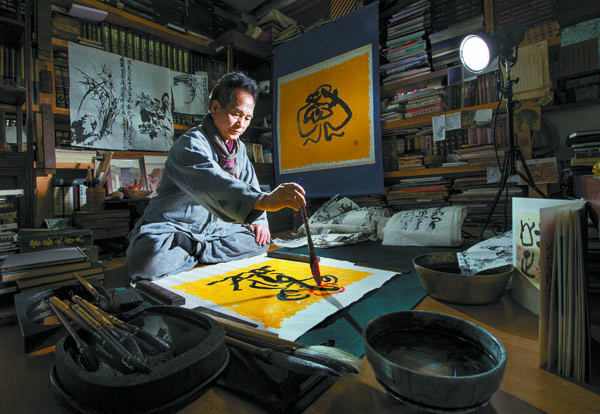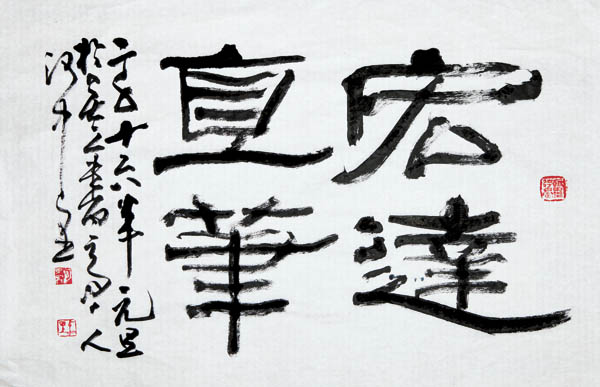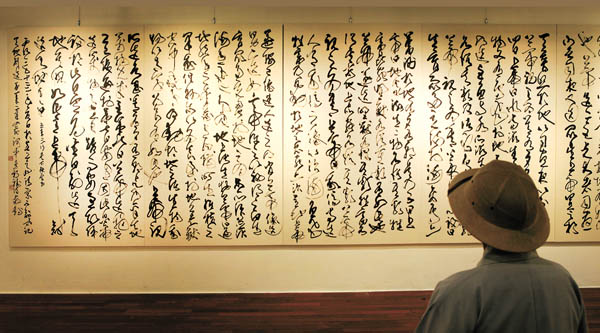[ZOOM KOREA] Keeping a vanishing art form alive

At his residence, calligrapher Ha Sang-ho concentrates fully while writing the character “banya.” Formally and aesthetically distinct, the hieroglyphic word signifies wisdom shared by the Buddha. [PARK SANG-MOON]
The evidence of his lifelong endeavor to elevate calligraphy is as thick as the scent of the ink stick that permeates his home.
“Calligraphy is a marker of the history and culture of humankind,” Ha said. “How else could we organize and contain all of that which spans thousands of years? The influence that calligraphy has on us humans, particularly in the minds of East Asians, is almost inexplicable. Pablo Picasso [1881-1973] also cited calligraphy, specifically cursive writing, as the greatest art in Asia.”
Beyond a recording tool, the process of recording itself has become an artistic practice, he explained. Calligraphy has come a long way, as it has been cherished steadily by Koreans over the centuries. However, since the Japanese colonial era (1910-45), calligraphy has gradually started to disappear.
In the modern era, people seem to have even less interest in calligraphy. The rise of computers and media culture has dealt a fatal blow to the progress of calligraphy. And yet, from the 1970s to the mid-’80s, there was a calligraphy boom. On each block stood at least one calligraphy academy, among which a few would even have over 100 students enrolled.
Citing China as an example, Ha asserted that there must be greater value and appreciation for calligraphy in Korea. As China is reviving its Confucian values and the value of art that disappeared during the Cultural Revolution, Chinese calligraphic art is currently experiencing a golden age.
Ha expressed dismay with the fact that, though in no way are Korea’s literature and art inferior to those of China, calligraphy seems to hold much less value among Korean citizens.
Ha emphasized the most important characteristic of calligraphy, which is that it treats written text as an artistic form. Because calligraphy represents the nation’s ideas and thoughts, it is crucial to not lose sight of its significance. In particular, because hangul, the Korean alphabet, is based on scientific calculations, there is still much more to be discovered and developed. That said, the renewed research and efforts to study Korean calligraphy, which has garnered global attention, have given Ha some hope.

For the reporters from the Korea JoongAng Daily, Ha writes, “goengdal jikpil.” The phrase narrates the life of a news reporter, highlighting the knowledge one obtains in the process of seeing, hearing, investigating and writing. [PARK SANG-MOON]
German psychiatrist and philosopher Karl Jaspers claimed that what he found most memorable in Japan was its National Treasure No. 1, a wooden statue of a crossed-legged thinking Buddha. But Ha noted that the statue was originally made in Korea. Similarly, Claude Debussy’s symphony “La Mer” was inspired by Japanese lithographic prints depicting the sea, but it has been said that it was Korean lithography that influenced Japan, leading to the development of the art form there.
As such, the majority of Japan’s art and culture stems from Korea, Ha said. And because the root of all this rich and influential art is in fact calligraphy, Koreans have a greater responsibility to revive and promote it.
Raised by a father who was a teacher of Chinese characters, Ha immersed himself in the world of calligraphy from the age of 4 when he began studying the “Thousand Character Classic,” a Chinese poem and tool for teaching Chinese characters to children dating back to the sixth century.

A calligraphic work by Ha that is approximately 2.6 by 2 meters (8.5 by 6.5 feet), written in cursive, narrates the story of Genesis from the Bible. [PARK SANG-MOON]
It has been said that legendary cellist Pablo Casals (1876-1973) strove to practice six to eight hours a day even when over the age of 90. He advised his students that it is the best way to improve one’s skills.
Likewise, Ha expressed his resolve to develop calligraphy through his continual practice. He wants to show that “practice is the mother of creation,” he said.
BY PARK SANG-MOON
[park.sangmoon@joongang.co.kr]










with the Korea JoongAng Daily
To write comments, please log in to one of the accounts.
Standards Board Policy (0/250자)